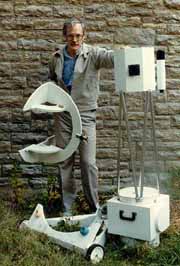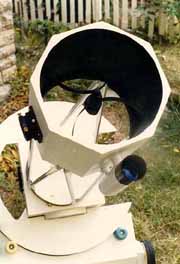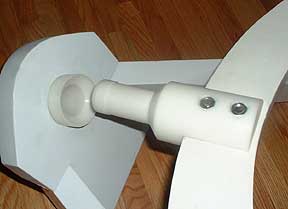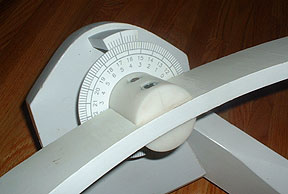A 10-inch Split Ring Newtonian Reflector
 My thanks to Joe Pearson for the inspiration to build
the split-ring Newtonian back in 1975. If you google this design (Joe Pearson 10-inch split-ring telescope), you will find that many other builders have had success in building it.
The design of the mount is similar to the original 200-inch Hale reflecting telescope on Mt. Palomar.
My thanks to Joe Pearson for the inspiration to build
the split-ring Newtonian back in 1975. If you google this design (Joe Pearson 10-inch split-ring telescope), you will find that many other builders have had success in building it.
The design of the mount is similar to the original 200-inch Hale reflecting telescope on Mt. Palomar.
 The scope breaks into three pieces for portability. The section
in my right hand was hinged and could be folded flat. The central split ring rides on a pair of roller-skate wheels.
The scope breaks into three pieces for portability. The section
in my right hand was hinged and could be folded flat. The central split ring rides on a pair of roller-skate wheels.
 I built an octagonal box to get the focuser as close to
the secondary mirror as possible, in order to use a small flat and minimize the secondary obstruction.
This time I used a 1.5-inch flat, with no image cut-off. The curved spider vanes were an attempt to defeat
the bright diffraction spikes that are caused by straight vanes. The diffraction spikes are still there but
you won't see them because they are spread out over the whole field and less objectionable. The absence of glare makes
some detail easier to see on bright planets. I would like to
believe that using curved vanes also results in improved contrast as well, but this has been more difficult to prove.
I built an octagonal box to get the focuser as close to
the secondary mirror as possible, in order to use a small flat and minimize the secondary obstruction.
This time I used a 1.5-inch flat, with no image cut-off. The curved spider vanes were an attempt to defeat
the bright diffraction spikes that are caused by straight vanes. The diffraction spikes are still there but
you won't see them because they are spread out over the whole field and less objectionable. The absence of glare makes
some detail easier to see on bright planets. I would like to
believe that using curved vanes also results in improved contrast as well, but this has been more difficult to prove.
 Recently, I replaced the main bearing with a sleeve and
rod turned from delrin, a plastic slicker than nylon but not as slick as teflon. A light touch of baby powder
makes the perfect lubricant. The scope turns as smoothly as you could want.
Recently, I replaced the main bearing with a sleeve and
rod turned from delrin, a plastic slicker than nylon but not as slick as teflon. A light touch of baby powder
makes the perfect lubricant. The scope turns as smoothly as you could want.
 In SurfCam, I drew an indexed circle with numbers,
projected the circle onto a surface, and machined it with a .020" cutter, all in virtual reality.
The program shows the machining on screen in 3-D. You see everything but the flying bits of dust. The
file was then posted to the Arrow 500 which did the actual cutting in a sheet of white plastic .080" thick.
Not exactly low-tech anymore, but then it's been 16 years since I started building this scope. There
is no reason to replace a good scope when you can keep upgrading it.
In SurfCam, I drew an indexed circle with numbers,
projected the circle onto a surface, and machined it with a .020" cutter, all in virtual reality.
The program shows the machining on screen in 3-D. You see everything but the flying bits of dust. The
file was then posted to the Arrow 500 which did the actual cutting in a sheet of white plastic .080" thick.
Not exactly low-tech anymore, but then it's been 16 years since I started building this scope. There
is no reason to replace a good scope when you can keep upgrading it.
 The declination circles (one on each side of the scope)
were drawn and cut as described above.
The declination circles (one on each side of the scope)
were drawn and cut as described above.